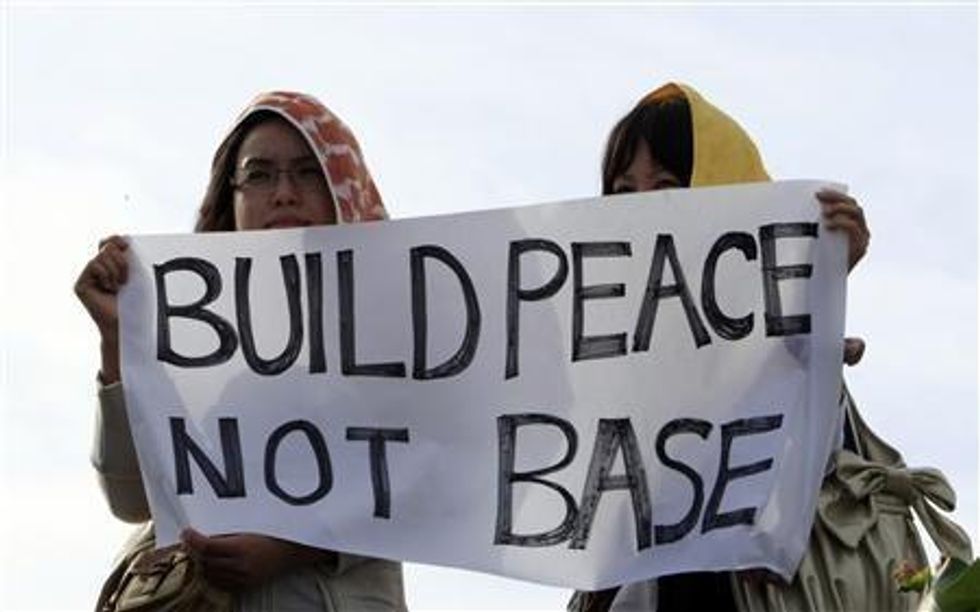Jan 14, 2014

In over a dozen tests conducted between 1961 and 1962, rice paddies were showered with rice blast fungus to evaluate its threat to rice crops, according to U.S. military documents reported by Kyodo News.
The fungus, described by scientists as a "threat to global food security," causes lesions to form on plants and is estimated to ruin enough rice crops to feed 60 million people each year.
Kyodo News reports that similar experiments were conducted in Taiwan, in addition to previously disclosed chemical and biological tests in the United States.
"The United States is believed to have had China and Southeast Asia in mind in developing such crop-harming agents," the report states.
For decades, Okinawa residents have resisted the U.S. military on the island, with continuous protests against the presence of U.S. service members, industrial pollution, sexual assaults, and the overall danger of neighboring a military installation.
A majority of Japan's U.S. military bases, and half of the 50,000 U.S. troops in the country, are located in Okinawa.
_____________________
Join Us: News for people demanding a better world
Common Dreams is powered by optimists who believe in the power of informed and engaged citizens to ignite and enact change to make the world a better place. We're hundreds of thousands strong, but every single supporter makes the difference. Your contribution supports this bold media model—free, independent, and dedicated to reporting the facts every day. Stand with us in the fight for economic equality, social justice, human rights, and a more sustainable future. As a people-powered nonprofit news outlet, we cover the issues the corporate media never will. Join with us today! |
Our work is licensed under Creative Commons (CC BY-NC-ND 3.0). Feel free to republish and share widely.
Sarah Lazare
Sarah Lazare was a staff writer for Common Dreams from 2013-2016. She is currently web editor and reporter for In These Times.

In over a dozen tests conducted between 1961 and 1962, rice paddies were showered with rice blast fungus to evaluate its threat to rice crops, according to U.S. military documents reported by Kyodo News.
The fungus, described by scientists as a "threat to global food security," causes lesions to form on plants and is estimated to ruin enough rice crops to feed 60 million people each year.
Kyodo News reports that similar experiments were conducted in Taiwan, in addition to previously disclosed chemical and biological tests in the United States.
"The United States is believed to have had China and Southeast Asia in mind in developing such crop-harming agents," the report states.
For decades, Okinawa residents have resisted the U.S. military on the island, with continuous protests against the presence of U.S. service members, industrial pollution, sexual assaults, and the overall danger of neighboring a military installation.
A majority of Japan's U.S. military bases, and half of the 50,000 U.S. troops in the country, are located in Okinawa.
_____________________
Sarah Lazare
Sarah Lazare was a staff writer for Common Dreams from 2013-2016. She is currently web editor and reporter for In These Times.

In over a dozen tests conducted between 1961 and 1962, rice paddies were showered with rice blast fungus to evaluate its threat to rice crops, according to U.S. military documents reported by Kyodo News.
The fungus, described by scientists as a "threat to global food security," causes lesions to form on plants and is estimated to ruin enough rice crops to feed 60 million people each year.
Kyodo News reports that similar experiments were conducted in Taiwan, in addition to previously disclosed chemical and biological tests in the United States.
"The United States is believed to have had China and Southeast Asia in mind in developing such crop-harming agents," the report states.
For decades, Okinawa residents have resisted the U.S. military on the island, with continuous protests against the presence of U.S. service members, industrial pollution, sexual assaults, and the overall danger of neighboring a military installation.
A majority of Japan's U.S. military bases, and half of the 50,000 U.S. troops in the country, are located in Okinawa.
_____________________
We've had enough. The 1% own and operate the corporate media. They are doing everything they can to defend the status quo, squash dissent and protect the wealthy and the powerful. The Common Dreams media model is different. We cover the news that matters to the 99%. Our mission? To inform. To inspire. To ignite change for the common good. How? Nonprofit. Independent. Reader-supported. Free to read. Free to republish. Free to share. With no advertising. No paywalls. No selling of your data. Thousands of small donations fund our newsroom and allow us to continue publishing. Can you chip in? We can't do it without you. Thank you.